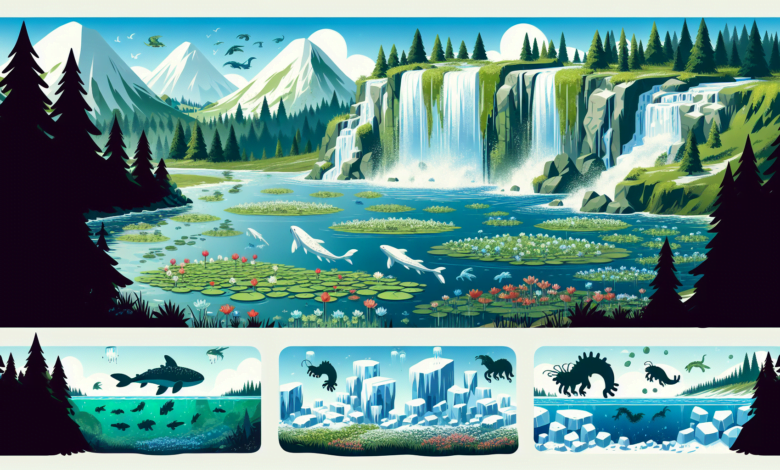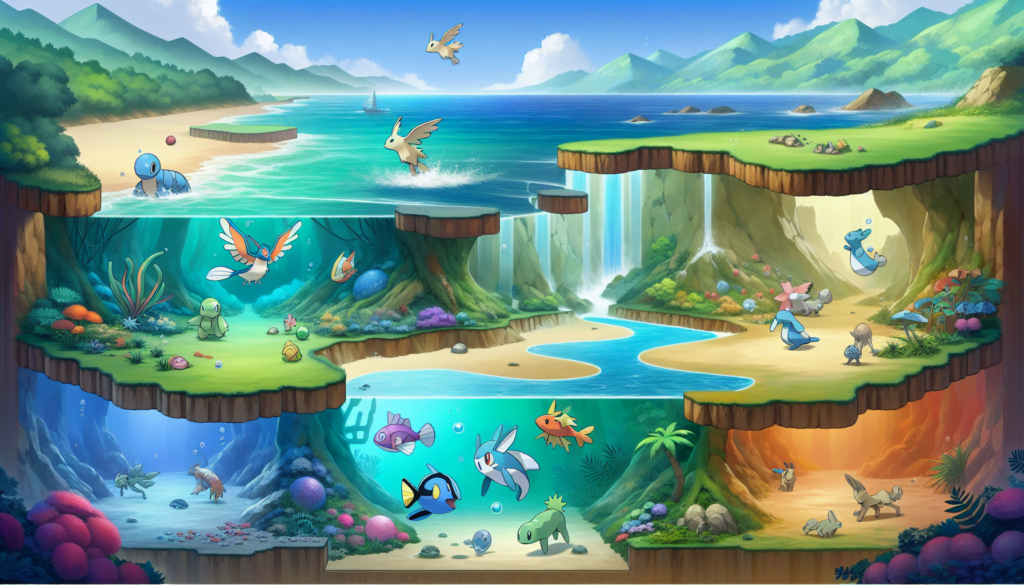Exploring Water Pokémon Habitats: Your Ultimate Guide to Biomes in Pokémon GO 2024
"Delving into Aquatic Realms: Unveiling Pokémon GO's Diverse Water Habitats"

In the dynamic world of Pokémon GO, introducing new biomes, including Beach, City, Forest, and Mountain, has transformed gameplay, offering unique backgrounds that enrich the gaming experience and make the hunt for Water Pokémon and others more immersive[1]. These environments are not just for show; they are meticulously designed to reflect the real-world locations of players, enhancing the thrill of discovering Biome-specific Pokémon, such as those from the Kanto region linked to specific biomes, with the promise of more to come[1]. From the common to the rare, this strategic integration of biomes in Pokémon GO hints at a deeper layer of gameplay, where understanding and leveraging these environments can be the key to becoming a true Pokémon master[1].
As trainers set out on their quest to catch them all, especially the elusive Water Pokémon, mastering the complexities of biomes becomes crucial[1]. The game’s biomes, influenced by real-life geographies and known to harbor unique Pokémon spawns, serve as a testament to Niantic’s commitment to mirroring the real world[1]. This guide is tailored to navigate the nuanced world of Pokémon GO biomes, revealing how trainers can identify their current biome, understand the effect of weather changes, and uncover the secrets behind the spawn patterns of Biome-specific Pokémon, including those affected by the phenomenon of ‘torrent’ [1].
Understanding Biomes in Pokémon GO
Biomes in Pokémon GO are intricately designed to reflect real-world ecosystems, influencing the appearance of the game environment and the types of Pokémon trainers encounter. These biomes are not just aesthetic but crucial for strategic gameplay, as they determine the Pokémon species that appear as wild spawns[1][2].
Critical Characteristics of Biomes:
- Variety and Types:
- Dynamic Changes:
- Impact of Special Events:
-
- During special events and different seasons, typical Pokémon spawns in biomes may alter, adding an element of unpredictability and excitement to the game[2].
- Real-World Influence:
Strategic Importance of Biomes:
- Each spawn point in the game has its biome property, which dictates the type of Pokémon that can potentially spawn there[2][5].
- Trainers exploring different areas can discover unique Pokémon specific to each biome, enhancing the exploratory and collectible aspects of the game[2].
- Biomes support both day and night cycles as well as seasonal changes, with visual modifications like blooming trees in spring or snowy landscapes in winter, depending on the trainer’s real-world location[3][6][7].
Real-World Mapping and Spawn Mechanics:
- Biomes are not tied to large geographic regions but are determined by individual spawn points[2].
- This means that spawn points with different biome properties can be very close to each other, sometimes leading to diverse Pokémon encounters within small areas[2].
- The exact location of a trainer dictates the Pokémon spawns, making each player’s experience unique based on their geographical surroundings[4].
Understanding these aspects of biomes in Pokémon GO allows trainers to plan their gameplay strategy better, predicting where certain Pokémon might appear and optimizing their chances of catching rare and biome-specific Pokémon like those influenced by the ‘torrent’ phenomenon[1].
Types of Biomes and Their Characteristics

Confirmed and Unconfirmed Biomes
Pokémon GO features a variety of biomes, each with distinct characteristics and associated Pokémon species. Four confirmed biomes exist: Beach, City, Forest, and Mountains. Additionally, there are unconfirmed biomes, including grasslands with or without trees and grassy areas near smaller bodies of water [12].
Biome Variations and Overlaps
Biomes in Pokémon GO can vary significantly in appearance based on their geographical location. For example, the Beach biome can appear as lakes, rivers, or oceans, and there are tropical variations with palm trees. Similarly, the City biome might include parks with buildings in the background, changing tree types to those with colored leaves during different seasons [11].
Pokémon Distribution Across Biomes
Each biome is known to host specific Pokémon species more frequently than others. For instance:
- Forest Biome: Commonly features Pokémon like Bulbasaur, Caterpie, Weedle, and Oddish [9].
- Beach Biome: Typically hosts water-related Pokémon such as Squirtle, Psyduck, Seel, Magikarp, and the newly introduced Wiglett [9].
- Mountain Biome: Known for Pokémon like Sandshrew, Clefairy, Zubat, and Diglett [9].
- City Biome: Includes urban Pokémon such as Caterpie, Pidgey, Machop, and Gastly [9].
Real-World Influence and Mapping
Biomes in Pokémon GO are designed based on the official USGS data set on global ecosystems, ensuring a realistic mapping that roughly corresponds to real-world locations. This geotagging helps create an immersive experience that mirrors geographic features [3][5].
Dynamic Nature of Biomes
Biomes are not static; they support dynamic changes influenced by seasons and day/night cycles. For example, during spring, trees within the biomes may bloom, and in autumn, leaves might turn yellow, providing a visually engaging environment that reflects the real world [3].
This dynamic aspect is further emphasized by the proximity of different Pokémon spawn points, which can lead to diverse Pokémon encounters even within small geographic areas [2].
How to Identify Your Current Biome
Identifying your current biome in Pokémon GO can be challenging, as no in-game map explicitly shows biome locations. However, players can use several strategies and community resources to determine the type of biome they are exploring. Here’s a step-by-step guide to help you pinpoint your current biome:
Step 1: Understand the Basics
It’s important to note that biomes in Pokémon GO are determined per spawn point and not over a large geographic area. This means that different biomes can exist very close to each other, sometimes even within a few meters [2].
Step 2: Observe Local Spawn Patterns
To start identifying your biome, pay close attention to the types of Pokémon that appear frequently in your area. For instance, you might be near a water biome if you notice a higher frequency of Water Pokémon like Dratini. Observing these patterns over time can give you a clearer idea of your local biome characteristics [2].
Step 3: Use Community-Created Resources
Since the game does not provide a biome map, many players rely on community-created resources and tools. Websites like OpenStreetMap or local guides written by Pokémon GO players can be invaluable. These resources often contain detailed information about where specific biomes will likely be found based on player experiences and data collection [12].
Step 4: Explore Geographic Features
Identifying your biome might be more straightforward if you live near distinct geographic features like seas, lakes, or rivers. Water edges are typically associated with water biomes. However, distinguishing other terrain types, such as forest or mountain biomes, can require more careful observation of the surrounding environment and the Pokémon species that spawn there [5].
Step 5: Check Community Forums and Social Media
Engaging with the Pokémon GO community through forums and social media platforms can also provide clues about your local biomes. Experienced players often share their findings and can offer tips on identifying and locating specific biomes based on spawn points [2].
By following these steps and utilizing available resources, trainers can enhance their understanding of the biomes around them, leading to more strategic gameplay and better chances of capturing rare and biome-specific Pokémon.
Effects of Weather on Biomes
Weather Influence on Pokémon Spawning and Combat
- Impact on Spawn Rates and Pokémon Types: Weather conditions significantly influence the spawning rates of Pokémon, making certain species more common during specific weather conditions. For example, Water-type Pokémon are more likely to appear during rainy weather [13][14].
- Enhancement of Pokémon Abilities in Combat: Pokémon that appear during certain weather conditions receive a combat advantage with a 1.2x CP multiplier, enhancing their effectiveness in battles [13].
Temporary Biome Alterations Due to Weather
- Adaptation of Biomes to Weather Conditions: Specific weather conditions can temporarily transform biomes, leading to the appearance of Pokémon not usually found in those areas. A notable instance is the emergence of Water-type Pokémon in desert biomes during sunny weather [13].
Strategic Opportunities from Weather-Biome Interactions
- Unique Catching Opportunities: The interaction between weather conditions and biomes can create unique opportunities for players to catch rare or region-specific Pokémon, adding an exciting layer of strategy to the game [13].
Weather Reporting and Game Mechanics
- Real-Time Weather Updates: Pokémon GO utilizes real-time weather data from AccuWeather to adjust game mechanics accordingly. This includes changes in spawn rates, encounter benefits, and in-battle power [14].
- Detailed Weather Effects on Gameplay:
-
- Spawn Rate Boosts: Certain weather conditions boost the spawn rates for Pokémon corresponding to that weather type, which is visually indicated by a swirling wind animation around the Pokémon [14].
- Encounter Benefits: Pokémon influenced by the weather yield extra Stardust, have a higher level and improved IVs, enhancing their value when caught [14].
- In-Battle Advantages: Moves corresponding to the current weather type receive a power boost, increasing the effectiveness of Pokémon in combat situations [14].
Weather and Geographic Impact
- Weather Assignment to Geographic Cells: The game divides the geographic landscape into “cells” where weather affects gameplay based on hourly forecasts. This system ensures that the in-game environment closely mimics real-world weather conditions [14].
- Extreme Weather Conditions and Safety: Pokémon GO defines extreme weather using reports from AccuWeather, which can affect gameplay by limiting the appearance of certain Pokémon types to ensure player safety [14].
By understanding these dynamics, players can optimize their gameplay strategy to take advantage of the varying effects of weather on Pokémon behavior and biome characteristics.
Biome-Specific Pokémon and How to Find Them
Identifying and Locating Biome-Specific Pokémon
Coastal and Water Biomes
- Water Pokémon Availability: While oceanic Pokémon are not directly catchable, coastal regions and areas near water bodies frequently spawn Water Pokémon like Dratini, a rare spawn in water biomes [8][2].
- Critical Locations for Water Pokémon: Players should focus on areas where water Pokémon are commonly found, especially near real-world water bodies, to increase their chances of encountering rare Pokémon like Dratini [2].
Forest and Mountain Biomes
- Forest Biome Residents: Known for spawning Grass and Bug-type Pokémon such as Bulbasaur and Caterpie. Observing these Pokémon can indicate a forest biome [11].
- Mountain Biome Inhabitants: Features Pokémon like Sandshrew and Clefairy. Finding such species can help identify mountain biomes [11].
City Biomes
- Urban Pokémon: Cities and towns, often represented as city biomes in Pokémon GO, are populated with Pokémon like Pidgey and Gastly, which are common in such environments [11].
Strategies for Finding Specific Pokémon
- Regular Checks in Known Biomes:
- Utilizing Events and Community Days:
-
- Participating in Pokémon GO events such as Community Days or special events like GO Fest provides opportunities to catch specific Pokémon that may not commonly appear in your local biomes [16].
- Exploration and Community Engagement:
Table of Confirmed Pokémon Spawns by Biome
|
Biome Type |
Confirmed Pokémon Spawns |
|---|---|
|
Beach |
Squirtle, Magikarp, Psyduck, Seel, Wiglett |
|
City |
Caterpie, Gastly, Machop, Pidgey |
|
Forest |
Bulbasaur, Caterpie, Oddish, Weedle |
|
Mountain |
Clefairy, Diglett, Sandshrew, Zubat |
This table includes Pokémon that are typically found in each confirmed biome, helping trainers plan where to focus their hunting efforts based on the desired Pokémon [1][5][6].
Understanding Spawn Patterns and Biome Indicators
- Biome Indicators: Recognizing the typical Pokémon of a biome can indicate the biome type. For example, frequent sightings of Bulbasaur and Weedle suggest a forest biome [11].
- Special Considerations for Rare Pokémon: Some Pokémon, like Dratini, are known to spawn only in specific biomes, such as water biomes, making them rare finds. Regular visits to these biomes during optimal conditions can significantly increase the chances of encountering these Pokémon [2].
By familiarizing themselves with the habitats of different Pokémon and regularly visiting these biomes, trainers can effectively enhance their Pokémon experience and increase their collection of rare and biome-specific Pokémon.
Seasonal Changes and Their Impact on Biomes
Understanding Seasonal Dynamics in Pokémon GO Biomes
Biomes in Pokémon GO are dynamic environments that change with the seasons, reflecting real-world seasonal changes. Each season in Pokémon GO lasts three months and is typically themed, tying together various in-game events and Pokémon appearances [18].
Seasonal Effects on Pokémon Spawns
- Variation in Pokémon Appearance: Depending on the season, different Pokémon from all generations become more prevalent in the wild. This variation ensures players experience a changing gameplay environment throughout the year [18].
- Seasonal Rarity Changes: Some Pokémon may become common during one season and rare in another, adding a layer of strategic planning for players seeking to complete their Pokédex [18].
Biome-Specific Changes Due to Seasons
The impact of seasons extends to the biomes themselves, with different Pokémon appearing based on the current season and the hemisphere the player is in. This means that the same biome can offer different Pokémon encounters in winter compared to summer [18].
Integration of Seasons with Pokémon GO Events
Pokémon GO events are closely tied to seasons, with each season featuring specific Mega Raids and other themed activities that allow various Pokémon to shine during their respective seasons [18]. The GO Battle League’s seasons also align with these overarching seasonal themes, creating a cohesive gameplay experience [18].
Seasonal Pokémon Forms
An exciting aspect of seasonal changes is the appearance of different forms of certain Pokémon, such as Deerling, whose appearance changes each season, providing players with a visually engaging and collectible aspect as they hunt for all four forms throughout the year [18].
Table of Seasonal Changes and Their Effects on Biomes
|
Season |
Impact on Biomes |
Notable Pokémon Changes |
|---|---|---|
|
Spring |
Increased appearances of floral Pokémon |
Deerling (Spring Form), increased Grass-types |
|
Summer |
Enhanced water biome activities |
Increased Water-types, Deerling (Summer Form) |
|
Autumn |
Leaf changes, more Ground and Rock-types |
Deerling (Autumn Form), increased spawning of Seedot |
|
Winter |
Snowy landscapes, Ice-types are more common |
Deerling (Winter Form), increased ice types |
This table illustrates how each season affects the types of Pokémon appearing and the visual and interactive aspects of the biomes, aligning with real-world seasonal changes [18].
By understanding and anticipating these seasonal changes, players can enhance their strategic approach to Pokémon GO, planning their exploration and Pokémon collection activities to align with the shifting biomes and Pokémon availability [18].
Utilizing Biomes for Strategic Gameplay
Strategic Exploration of Biomes
Biomes in Pokémon GO are designed to enhance the exploration experience by varying the Pokémon available in different areas. Players are encouraged to explore diverse locations to encounter a wide range of Pokémon species [17]. This strategic exploration is crucial, especially during events and seasonal changes affecting Pokémon’s appearances in these biomes [6].
Event and Seasonal Strategy
Introducing events and seasons in Pokémon GO adds a layer of strategy to biome exploration. Specific events may increase the spawn rates of certain Pokémon in their respective biomes, allowing players to catch rare Pokémon like Shiny Bulbasaur, Shiny Charmander, and Shiny Squirtle [17]. Understanding which events affect which biomes can significantly enhance a player’s ability to collect rare species and complete particular research tasks, such as those offered during the ‘Rediscover Kanto’ event [12][17].
Leveraging Biome Characteristics
While biomes may not always directly correlate with spawn data, recognizing the general characteristics of each biome can guide players in predicting where certain Pokémon might appear. For instance, water-related Pokémon are typically found near water biomes, despite the same species occasionally appearing in different biomes under particular conditions [15].
Utilizing Community and Research Events
Community Days and special research events are prime times for players to take advantage of biome-specific characteristics. These events often provide bonuses such as increased experience points and learning Community Day moves for starter Pokémon, which are biome-dependent [17]. Engaging in field research during these events can also yield additional rewards like Mega Energy for specific Pokémon [17].
Table of Strategic Biome Utilization During Events
|
Event Type |
Biome Impact |
Strategic Benefits |
|---|---|---|
|
Community Day |
Increased spawns in specific biomes |
Higher chances of encountering Shiny Pokémon |
|
Special Research |
Tasks tied to biome-specific Pokémon |
Access to rare Pokémon and exclusive rewards |
|
Seasonal Changes |
Shift in Pokémon availability per biome |
Opportunity to catch varied Pokémon species |
By understanding and strategically planning gameplay around these biome characteristics and event schedules, players can optimize their Pokémon experience, making each exploration session both rewarding and efficient.
Common Myths and Misconceptions About Biomes
Misconception 1: Biomes Determine Rarity and Type of Pokémon
It is a common belief that biomes dictate the rarity or types of Pokémon that appear. However, the spawn points, not the biomes, determine where and what type of Pokémon will appear [13]. Even rare Pokémon can appear in any biome, and similarly, common Pokémon can be found across various biomes [13].
Misconception 2: Specific Pokémon Are Tied to Real-World Habitats
Another misconception is that certain Pokémon are exclusively tied to specific real-world habitats. In reality, while biomes influence the likelihood of encountering certain types of Pokémon, they do not restrict the presence of Pokémon to specific real-world habitats [13].
Misconception 3: “Nearby” Tracking and Biomes
Players often think that the “nearby” tracking feature in Pokémon GO considers biomes to suggest nearby Pokémon. However, this feature does not consider biomes when displaying nearby Pokémon [13].
Misconception 4: Influence of Biomes on Egg Hatches
There is also a misunderstanding that biomes influence the type or rarity of Pokémon that hatch from eggs. Biomes impact egg hatches, as these are randomized across the game [13].
Misconception 5: Existence of “Nest” Biomes
The concept of “nest” biomes, where specific Pokémon species spawn more frequently, has been debunked. While certain areas may experience frequent spawns of specific Pokémon, these are not considered special biome categories within the game [13].
Misconception 6: In-Game Indicators for Biomes
Due to the lack of in-game indicators for biomes, the community has created maps to identify biome distributions. These community-created maps are helpful but unofficial and not directly supported by the game’s data [12].
Misconception 7: Biomes and Water-Type Pokémon
A prevalent myth is that water-type Pokémon are exclusively found in water-based biomes. Water-type Pokémon can be encountered in various biomes, not just water-based [13].
By understanding these myths and misconceptions, players can better understand how biomes function in Pokémon GO and strategize their gameplay more effectively.
Conclusion Water Pokémon
Through this comprehensive exploration of habitats and biomes in Pokémon GO, we’ve delved into the intricacies of how different environments influence the Pokémon that trainers can encounter and catch. From the dynamic changes introduced by seasons and weather to the strategic significance of understanding biome characteristics for enhanced gameplay, the guide has aimed to equip trainers with the knowledge to navigate the varied landscapes of this immersive game effectively. The richness of Pokémon GO’s biomes, influenced by real-world geography and climate, not only adds depth to the gaming experience but also encourages players to explore and appreciate the diversity of their surroundings in pursuit of becoming Pokémon masters.
As we conclude, we must recognize our findings’ broader implications for novice and seasoned players. The strategic exploration of biomes, combined with understanding seasonal shifts and weather influences, opens up new avenues for capturing rare and biome-specific Pokémon. This enriches the gaming experience and underscores the game’s potential to foster community engagement and outdoor activity. With continual updates and the introduction of new features, Pokémon GO remains a dynamic platform for gamers to explore the natural world, highlighting the synergy between virtual gaming and real-world discovery. As trainers continue their journeys, let the knowledge of biomes and habitats guide their path to discovering not just rare Pokémon but also the beauty and diversity of the surrounding environment.
FAQs
1. How can I determine my biome while playing Pokémon GO?
You can identify the biome you are in by observing the visual cues on the Pokémon encounter screen in Pokémon GO. The graphics and environment shown will correspond to the biome you are exploring.
2. Where are the best places to find Water-type Pokémon in Pokémon GO?
Water-type Pokémon are typically found near bodies of water. Locations such as beaches and piers are hotspots for encountering Water-type Pokémon. Conversely, you are more likely to encounter Ground-type Pokémon in desert areas. Additionally, weather conditions can influence the frequency of different Pokémon appearances.
3. What does a biome-specific Pokémon mean in Pokémon GO?
In Pokémon GO, certain biomes are associated with specific Pokémon that are more likely to appear in those areas. For instance, the forest biome is known for Kanto region Pokémon like Bulbasaur, Caterpie, Weedle, and Oddish. Beach biomes are frequented by Pokémon such as Squirtle, Psyduck, Seel, and Magikarp, while mountain biomes may feature Sandshrew, Clefairy, Zubat, and Diglett.
4. How can I search for a specific Pokémon in Pokémon GO?
To find a specific Pokémon in Pokémon GO, you can use the search function in various ways:
- Pokédex number: Enter the number associated with a Pokémon to see all occurrences of that Pokémon in your list. For example, entering “25” will display all Pikachu.
- Pokémon type: Type in the desired Pokémon type to filter and display all Pokémon of that type in your list, such as all grass-type Pokémon when you search for “grass.”





